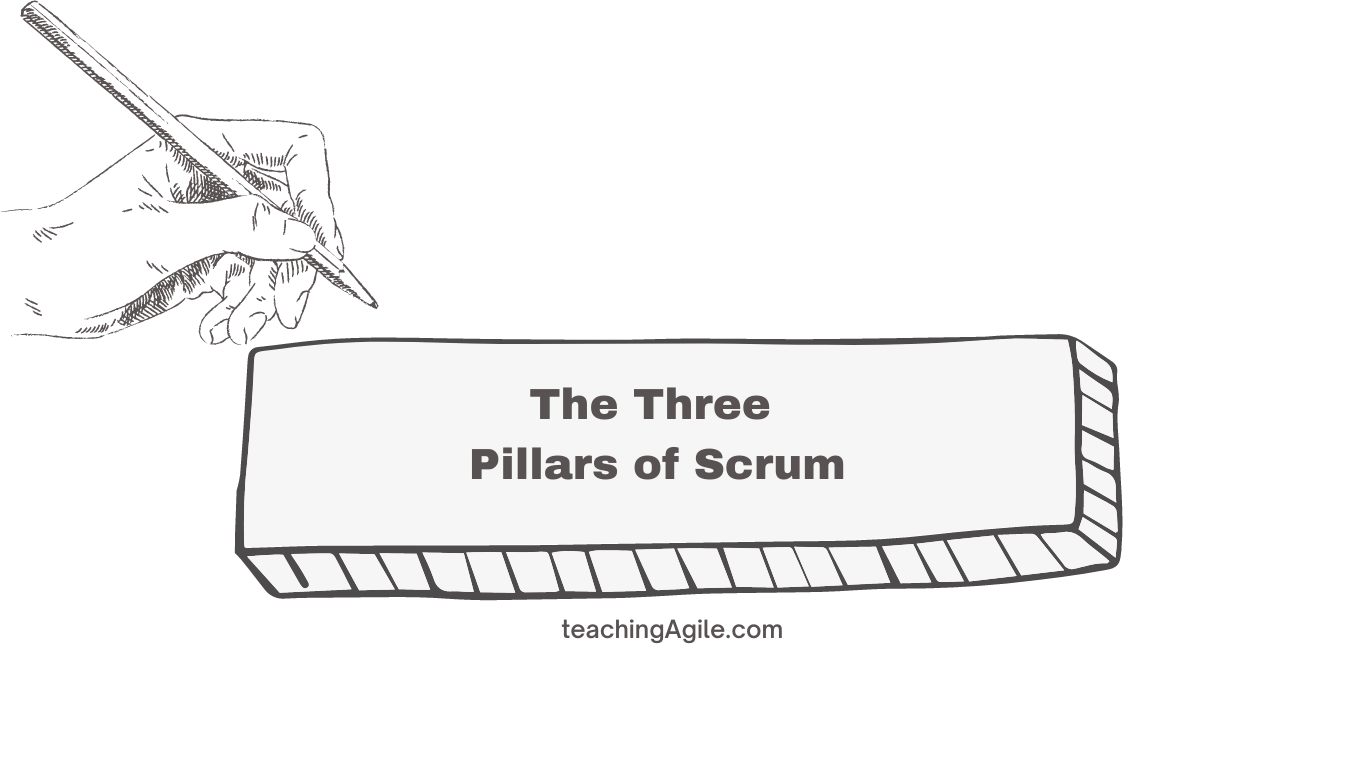
The Three Pillars of Scrum
 The Three Pillars of Scrum
The Three Pillars of Scrum
The three pillars of Scrum—transparency, inspection, and adaptation—form the empirical foundation of the Scrum framework.
These interconnected pillars enable teams to manage complexity through observation and experimentation rather than extensive upfront planning.
Transparency ensures all significant aspects of work are visible to those responsible for outcomes.
Teams make progress, impediments, and definitions clear to everyone.
This visibility enables informed decisions and builds trust across the Scrum Team and stakeholders.
Inspection involves frequent examination of Scrum artifacts and progress toward goals.
Scrum events—Sprint Planning, Daily Scrum, Sprint Review, Sprint Retrospective—create structured inspection points.
Teams detect variances or problems early, when they're cheapest to address.
Adaptation occurs when inspection reveals that aspects deviate outside acceptable limits or results will be unacceptable.
Teams adjust their process or materials being produced.
Adaptation happens continuously, not just at formal events.
This creates rapid feedback loops that minimize waste.
Key characteristics: The three pillars work together as an integrated system, not independently.
Transparency enables effective inspection.
Inspection without transparency yields misleading conclusions.
Adaptation without inspection is random change, not improvement.
Inspection without adaptation wastes the learning opportunity.
This systematic approach to empirical process control distinguishes Scrum from predictive planning methodologies.
Critical insight: The three pillars create self-correcting feedback loops at multiple timescales.
Daily Scrums provide 24-hour inspection-adaptation cycles.
Sprint Reviews create Sprint-length product feedback loops.
Sprint Retrospectives generate Sprint-length process improvement cycles.
This multi-scale empiricism enables teams to respond to change rapidly while continuously improving both product and process.
Organizations that implement Scrum ceremonies without embracing transparency, meaningful inspection, or actual adaptation miss the framework's empirical core.
Quick Answer: Three Pillars of Scrum at a Glance
| Pillar | Definition | How It Manifests in Scrum |
|---|---|---|
| Transparency | All significant aspects of work are visible to those responsible for outcomes | Product Backlog visible to all, Sprint Backlog updated daily, Increment demonstrated at Sprint Review, shared Definition of Done |
| Inspection | Frequent examination of Scrum artifacts and progress toward goals | Daily Scrum (24-hour inspection), Sprint Review (Increment inspection), Sprint Retrospective (process inspection), continuous backlog refinement |
| Adaptation | Adjusting process or product when inspection reveals deviation | Daily Scrum replan for Sprint Goal, Sprint Review updates Product Backlog, Sprint Retrospective identifies improvements, Sprint Planning adapts approach |
Table of Contents
Transparency
Transparency is essential for Scrum to work effectively. That is the case for anything in life. Without transparency, everyone will be in a constant feeling of being tricked.
Everyone involved should be able to see all aspects of your endeavor, including the work, progress, and obstacles encountered. This ensures that all team members are on the same page and that any issues can be identified and resolved promptly.
Transparency in Scrum helps to:
- Build trust among team members and stakeholders.
- Facilitate open communication and collaboration.
- Ensure that everyone clearly understands project goals, requirements, and status.
To maintain transparency, the Scrum team should:
- Use a shared and up-to-date Product Backlog.
- Maintain a visible Sprint Backlog during the Sprint - Scrum Artifact.
- Share progress during the Daily Scrum and Sprint Review.
Inspection
Inspection is the routine examination of the project's development and work. This expedites the identification of future issues, allowing them to be resolved before they cause significant delays or disruptions.
Inspections can be conducted through formal meetings, informal conversations, or simply by observing the work.
Inspection activities in Scrum include:
- Detect issues early and take corrective actions.
- Continuously refine the Product Backlog and improve the development process.
- Monitor progress towards the Sprint Goal and adjust the plan as needed.
In Scrum, inspection occurs during the following:
- Daily Scrum: Team members inspect their progress and update the Sprint Backlog.
- Sprint Review: The team and stakeholders check the Increment and update the Product Backlog.
- Sprint Retrospective: The team inspects their performance and identifies improvements for the next Sprint.
Adaptation
Adaptation, the third pillar of Scrum, is about making necessary changes to improve the project's outcomes and the team's performance. Based on the insights gained during the Inspection phase, the team adapts their processes, tools, and techniques to optimize their work and deliver better results.
Adaptation can take various forms, such as:
- Respond effectively to changes in requirements, market conditions, or stakeholder feedback.
- Continuously improve the team's performance and product quality.
- Enhance the team's ability to deliver value to customers.
Adaptation occurs throughout the Scrum process as the team adjusts its plans, procedures, and work based on the insights gained from the inspection.
Conclusion
The three pillars of Scrum, i.e., Transparency, Inspection, and Adaptation, work together to create a feedback loop that enables continuous improvement and ensures the team remains aligned with the project's goals. By fostering a transparent environment, the team can effectively inspect their work and adapt their processes to overcome challenges and deliver value to their customers.
Embracing these three pillars is critical to the success of any Scrum project, as they form the foundation of the Agile mindset and promote a culture of collaboration, continuous improvement, and customer-centricity.
Quiz on The Three Pillars of Scrum
Your Score: 0/15
Question: What are the three pillars of Scrum?
Frequently Asked Questions (FAQs) / People Also Ask (PAA)
How do the three pillars of Scrum relate to the scientific method?
Can you implement Scrum successfully without all three pillars?
How do the three pillars apply in highly regulated industries like healthcare or finance?
What's the difference between transparency in Scrum and micromanagement?
How do the three pillars enable remote and distributed team collaboration?
How do the three pillars relate to psychological safety?
How do AI and automation tools impact the three pillars?
What's the relationship between the three pillars and Lean thinking?
How do the three pillars apply to scaling Scrum across multiple teams?
How do cultural differences affect implementation of the three pillars?
How do the three pillars prevent technical debt accumulation?
How do the three pillars relate to DevOps and continuous delivery?
What happens when only management understands the three pillars?
How do the three pillars apply to hardware development?
How do the three pillars interact with organizational change management?